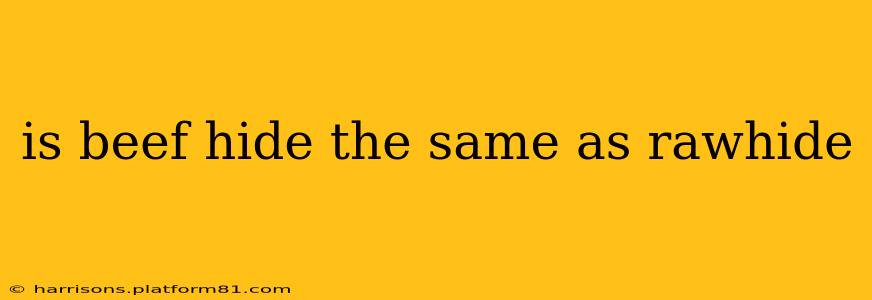Many pet owners wonder about the difference between beef hide and rawhide chews. While the terms are often used interchangeably, there are key distinctions to understand, especially regarding the safety and nutritional value for your furry friend. This comprehensive guide will clarify the differences and help you make informed decisions about the best chews for your dog.
What is Beef Hide?
Beef hide refers to the raw, untreated skin of cattle. It's the starting point for many pet products, including rawhide chews. However, simply being "beef hide" doesn't automatically translate to a safe or healthy chew for your dog. The processing significantly impacts the final product.
What is Rawhide?
Rawhide, in its purest form, is also derived from beef hide. However, the crucial difference lies in the extensive processing it undergoes. This process typically involves cleaning, splitting, washing, and often, treating the hide with chemicals to preserve it, make it more pliable, and extend its shelf life. This processing can significantly alter the nutritional value and even introduce potential health risks.
Are they the same? The Simple Answer: No.
While both originate from beef hide, the extensive processing of rawhide transforms it into a very different product than a simple piece of untreated beef hide. Think of it like comparing fresh fruit to fruit leather – similar origins, vastly different final products.
What are the potential problems with Rawhide chews?
Several concerns surround rawhide chews:
Potential for Choking Hazards: Rawhide can break into large, hard pieces that can cause choking, especially in smaller dogs. The texture can also be difficult to digest, leading to blockages.
Chemical Treatments: The processing often involves chemicals to preserve and treat the hide, potentially introducing harmful substances that your dog might ingest.
Bacterial Contamination: Rawhide chews can harbor bacteria if not properly cleaned and processed. This poses a risk of foodborne illness for your pet.
Nutritional Value: The highly processed nature of rawhide significantly diminishes its nutritional value. While it can provide some chewing satisfaction, it doesn't offer the same benefits as other, healthier chews.
Can Rawhide Cause Digestive Problems?
Yes, rawhide can indeed cause digestive upset. The tough texture and potential for ingestion of large pieces can lead to constipation, diarrhea, vomiting, or even intestinal blockages.
What are the benefits of beef hide chews (if properly sourced and prepared)?
Choosing properly sourced and minimally processed beef hide chews can offer advantages over heavily processed rawhide:
- Natural: Minimally processed beef hide offers a more natural chewing option.
- Potentially better digestibility: Depending on the preparation method, it may be easier for dogs to digest than heavily processed rawhide.
- Less likely to contain harmful chemicals: Minimally processed options reduce exposure to chemicals used in the rawhide production process.
Important Note: Even minimally processed beef hide requires careful supervision while your dog chews on it. Monitor for any signs of excessive chewing, ingestion of large pieces, or digestive upset.
What are some safer alternatives to Rawhide?
Many safer and equally engaging alternatives to rawhide exist, including:
- Bully sticks: These are dried beef pizzles (penis) and are a natural and digestible chew.
- Dental chews: Many dental chews are designed to clean teeth and improve breath while being easy to digest.
- Nylabones: These durable nylon chews are virtually indestructible and offer a long-lasting chewing experience.
- Frozen carrots or bananas: These provide a refreshing chew and some nutritional value.
Ultimately, choosing the right chew depends on your dog's size, chewing habits, and preferences. Always prioritize safety and consult with your veterinarian if you have any concerns.
Choosing between beef hide and rawhide requires careful consideration of processing methods and potential health risks. By understanding the differences and exploring safer alternatives, you can ensure your dog enjoys a healthy and enjoyable chewing experience.
